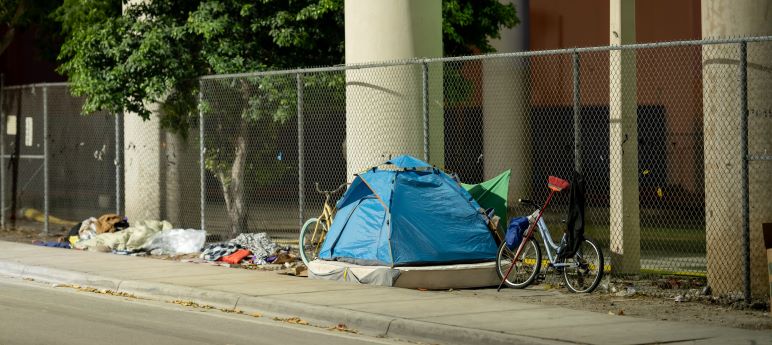The Bay Area could end homelessness with an $11.8 billion investment, according to a report released Thursday by the Bay Area Council, a business advocacy group.
The report calls for one-time investments totalling $9.3 billion and $2.5 billion in annual investments. Authors of the report say the money could come from local, regional, and state sources, including a voter-approved measure that could raise $10 billion.
Sobering statistics on homelessness in the region show that 73 percent of the homeless population is unsheltered, the highest rate in the nation.
The rise in homelessness in the region has accounted for 30 percent of total rise in homelessness in the country since 2017. Since 2010, the Bay Area's homeless population has grown four times faster than the region's population.
“They (homeless people) are our neighbors,” said Oakland Mayor Libby Schaaf, who is vice chair of the Bay Area Council's Economic Institute, which wrote the report.
Earlier this week, Schaaf and two Oakland city councilmembers announced legislation to provide opportunities for the private market to supply Oakland with lower-cost housing such as mobile and manufactured homes.
The legislation also provides opportunities for people to live in tiny homes and recreational vehicles without the fear of having to leave those homes at some point.
“They (homeless people) deserve better” and we must do better, said Paul Markovich, president and CEO of Blue Shield of California, which provided support for the report.
More state funding is key to achieving some goals in the report and state lawmakers face a June 15 deadline to approve a new state budget.
Researchers at the institute, including economist Adrian Covert, who presented the report's findings in a webinar Thursday morning, suggests taking an approach that hasn't been tried before in the U.S.
That approach goes beyond a mandate to provide shelter to people, something Gov. Gavin Newsom proposed at one time.
Mandates have been effective in New York and other places in getting people off the street, but people are languishing in shelters for years.
Instead, the institute's team recommended a blended approach that includes increasing the number of temporary or emergency shelters, expanding services such as rental assistance so people can stay in their homes, and building lots of housing for extremely low-, very low- and low-income residents.
The institute's researchers also recommend investing in mental health and substance abuse programs, something they said is critical.
“We have an opportunity to improve on what's been done before,” Covert said.
The report recommends passing the $10 billion ballot measure and passing legislation to make it easier to build new housing, especially rental housing.
It also recommends declaring a shelter crisis in cities where 10 percent of the homeless people are unsheltered. That could trigger the quick approval of new shelters.
Lastly, it recommends more federal money to fully fund the Section 8 program.
“I think it's time to take it with the seriousness it (homelessness) deserves,” Markovich said.


That’s expenditure, public (taxpayer) expenditure, not “investment” [sic].
And stop viewing the federal government as a parent, including for sponging.
The report recommends passing the $10 billion ballot measure and passing legislation to make it easier to build new housing, especially rental housing.
So you blow a billion dollar measure on consultants lawyers and ngo ceos, so of course the remedy is pass a 10B one…
When will you take responsibility for your failures and stop dumping on the people who fund this all, tax paying citizens, and the people who house non owners the most cost effectively, the landlords?
never, because you dont listen of have to listen, you are entitled to take without accountability
How many times do we need to see this movie? There have been multiple 3, 5, and 10 year plans to “end homelessness”. All have failed.
Conveniently no diagnosis as to why or which treatment options are appropriate for various homeless segments. Nor are recipients of public funds required to prepared audited statements as to outcomes.
Why not prioritize those most likely to become productive members of society or families with minor children for assistance?
How many billions have we already spent? How many billions have we committed in previous votes?
Why would we believe throwing another $9.3 billion, plus $2.5 billion per year would make any difference?
Seriously stop wasting taxpayer money on a lost cause. I say start with mental health care and drug rehabilitation. Once you get them stable and clean, they should be able to take care of themselves.